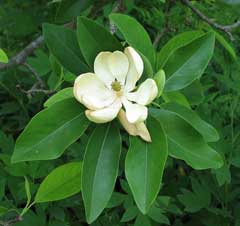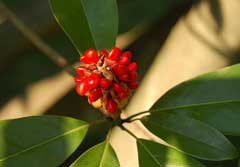 |
|
Photo by and (c)2008 Derek Ramsey (Ram-Man). Co-attribution must be given to the Chanticleer Garden. |
 |
| Photo (c)2007 Derek Ramsey (Ram-Man) |
Translate this page:
Summary
Physical Characteristics

 Magnolia virginiana is a deciduous Tree growing to 10 m (32ft) by 6 m (19ft) at a slow rate.
Magnolia virginiana is a deciduous Tree growing to 10 m (32ft) by 6 m (19ft) at a slow rate.
See above for USDA hardiness. It is hardy to UK zone 5 and is not frost tender. It is in flower from June to September. The species is hermaphrodite (has both male and female organs) and is pollinated by Beetles.
Suitable for: light (sandy), medium (loamy) and heavy (clay) soils and prefers well-drained soil. Suitable pH: mildly acid and neutral soils. It can grow in semi-shade (light woodland) or no shade. It prefers moist soil. It can tolerate atmospheric pollution.
UK Hardiness Map
US Hardiness Map
Synonyms
M. glauca.
Plant Habitats
Woodland Garden Canopy; Secondary;
Edible Uses
Edible Parts:
Edible Uses: Condiment Tea
The leaves are used as a condiment in gravies etc[183]. A tea is made from the leaves[183].
References More on Edible Uses
Medicinal Uses
Plants For A Future can not take any responsibility for any adverse effects from the use of plants. Always seek advice from a professional before using a plant medicinally.
Aromatic Astringent Bitter Diaphoretic Febrifuge Hallucinogenic Malaria Stimulant
A tea made from the bark is antiperiodic, aromatic, diaphoretic, laxative, stimulant and tonic[4, 222]. It has historically been used as a substitute for quinine in the treatment of malaria[222, 238] and is also taken internally in the treatment of colds, bronchial diseases, upper respiratory tract infections, rheumatism and gout[238, 257]. The bark has been chewed by people trying to break the tobacco habit[222]. The bark is harvested in the autumn and dried for later use[238]. It does not store well so stocks should be renewed annually[238]. A tea made from the fruit is a tonic, used in the treatment of general debility and was formerly esteemed in the treatment of stomach ailments[222]. The leaves or bark have been placed in cupped hands over the nose and inhaled as a mild hallucinogen[257].
References More on Medicinal Uses
The Bookshop: Edible Plant Books
Our Latest books on Perennial Plants For Food Forests and Permaculture Gardens in paperback or digital formats.

Edible Tropical Plants
Food Forest Plants for Hotter Conditions: 250+ Plants For Tropical Food Forests & Permaculture Gardens.
More

Edible Temperate Plants
Plants for Your Food Forest: 500 Plants for Temperate Food Forests & Permaculture Gardens.
More

More Books
PFAF have eight books available in paperback and digital formats. Browse the shop for more information.
Shop Now
Other Uses
Wood
An essential oil from the flowers has been used in the manufacture of perfumes[227]. Wood - straight-grained, light, soft, easily worked, finishes well, aromatic and yellow in colour[4, 46, 61, 229]. It weighs 31lb per cubic foot[227]. Used for furniture, broom handles, bowls and light woodenware articles etc[46, 61, 227, 229].
Special Uses
Food Forest Scented Plants
References More on Other Uses
Cultivation details
Requires a sunny sheltered position in a deep soil that does not dry out in the summer[11]. Plants are also tolerant of wet soils[238]. Succeeds in acid or neutral soils in sun or part shade[184]. Dislikes limey soils[11]. Tolerates some alkalinity so long as there is at least 50cm of good soil above the alkaline layer[202]. The branches are brittle so a sheltered position is required[200]. Plants are very tolerant of atmospheric pollution[200]. Mature dormant plants are hardy to about -20°c but the flowers are easily damaged by frost or wind.[184]. A warmth-loving species, it is best grown in the south and east of Britain[11]. The fleshy roots are easily damaged and any transplanting is best done during a spell of mild moist weather in late spring[182]. A slow growing tree but it flowers whilst young[182]. The flowers have a delicious scent of lemons[182]. A number of cultivars have been developed for their ornamental value. The plant is heat tolerant in zones 9 through 6. (Plant Hardiness Zones show how well plants withstand cold winter temperatures.
Plant Heat Zones show when plants would start suffering from the heat.
The Plant Heat Zone map is based on the number of "heat days" experienced in a given area where the temperature climbs to over 86 degrees F (30°C).
At this temperature, many plants begin to suffer physiological damage. Heat Zones range from 1 (no heat days) to 12 (210 or more heat days).
For example Heat Zone. 11-1 indicates that the plant is heat tolerant in zones 11 through 1.) For polyculture design as well as the above-ground architecture (form - tree, shrub etc. and size shown above) information on the habit and root pattern is also useful and given here if available. The plant growth habit is a standard with a non-suckering single trunk [1-2]. An evergreen. The root pattern is a heart root, dividing from the crown into several primary roots going down and out [1-2].
References Carbon Farming Information and Carbon Sequestration Information
Temperature Converter
Type a value in the Celsius field to convert the value to Fahrenheit:
Fahrenheit:
The PFAF Bookshop
Plants For A Future have a number of books available in paperback and digital form. Book titles include Edible Plants, Edible Perennials, Edible Trees,Edible Shrubs, Woodland Gardening, and Temperate Food Forest Plants. Our new book is Food Forest Plants For Hotter Conditions (Tropical and Sub-Tropical).
Shop Now
Plant Propagation
Seed - best sown as soon as it is ripe in a cold frame. Stored seed must be kept cold over the winter and should be sown in late winter in a cold frame[200]. The seed usually germinates in the spring but it can take 18 months. Prick out the seedlings into individual pots when they are large enough to handle and grow them on in light shade in a cold frame or greenhouse for at least their first winter. They can be planted out into their permanent positions when they are more than 15cm tall, though should be well mulched and given some protection from winter cold for their first winter or two outdoors. Layering in early spring[200].
Other Names
If available other names are mentioned here
Native Range
NORTHERN AMERICA: United States, Massachusetts, New Jersey, New York (southeast), Pennsylvania (southeast), Alabama, Arkansas, Delaware, Florida, Georgia, Louisiana, Maryland, Mississippi, North Carolina, South Carolina, Tennessee, Virginia (east), District of Columbia, Texas,
Weed Potential
Right plant wrong place. We are currently updating this section.
Please note that a plant may be invasive in one area but may not in your area so it's worth checking.
Conservation Status
IUCN Red List of Threatened Plants Status :

| Related Plants
|
| Latin Name | Common Name | Habit | Height | Hardiness | Growth | Soil | Shade | Moisture | Edible | Medicinal | Other |
| Liriodendron tulipifera | Tulip Tree, Tulip Poplar, Yellow Poplar, Canary Whitewood | Tree | 30.0 |
4-9
| M | LMH | N | M | 1 | 2 | 3 |
| Magnolia acuminata | Cucumber Tree, Cucumber Magnolia | Tree | 20.0 |
3-8
| M | LMH | SN | M | 0 | 3 | 2 |
| Magnolia campbellii | | Tree | 20.0 |
7-10
| | LMH | SN | M | 0 | 0 | 2 |
| Magnolia denudata | Lily Tree, Yulan Magnolia | Tree | 10.0 |
5-9
| S | LMH | SN | M | 1 | 2 | |
| Magnolia dodecapetala | Bwapen mawon | Tree | 35.0 |
10-12
| S | LMH | N | M | 0 | 0 | 4 |
| Magnolia grandiflora | Southern Magnolia, Bull Bay, Large-flowered Magnolia, Southern Magnolia | Tree | 10.0 |
6-10
| M | LMH | SN | M | 2 | 2 | 3 |
| Magnolia hypoleuca | Whitebark Magnolia | Tree | 15.0 |
5-9
| M | LMH | SN | M | 2 | 2 | 2 |
| Magnolia kobus | Kobus magnolia, Northern Japanese Magnolia | Tree | 12.0 |
4-7
| M | LMH | SN | M | 1 | 1 | 2 |
| Magnolia liliiflora | Mu-Lan, Woody Orchid, Lily Magnolia | Shrub | 3.0 |
4-9
| M | LMH | SN | M | 0 | 3 | |
| Magnolia macrophylla | Bigleaf Magnolia | Tree | 10.0 |
5-8
| S | LMH | SN | M | 0 | 1 | 2 |
| Magnolia officinalis | Hou Po | Tree | 20.0 |
7-10
| | LMH | SN | M | 0 | 3 | 2 |
| Magnolia stellata | Star Magnolia | Shrub | 5.0 |
4-8
| S | LMH | SN | M | 1 | 0 | |
| Michelia figo | Banana Shrub, Michelia | Shrub | 5.0 |
8-10
| M | LMH | SN | M | 1 | 0 | |
| Schisandra chinensis | Magnolia Vine, Wu Wei Zi | Climber | 9.0 |
4-8
| M | LMH | FS | M | 4 | 5 | 2 |
|
Growth: S = slow M = medium F = fast. Soil: L = light (sandy) M = medium H = heavy (clay). pH: A = acid N = neutral B = basic (alkaline). Shade: F = full shade S = semi-shade N = no shade. Moisture: D = dry M = Moist We = wet Wa = water.
Now available:
Food Forest Plants for Mediterranean Conditions
350+ Perennial Plants For Mediterranean and Drier Food Forests and Permaculture Gardens.
[Paperback and eBook]
This is the third in Plants For A Future's series of plant guides for food forests tailored to
specific climate zones. Following volumes on temperate and tropical ecosystems, this book focuses
on species suited to Mediterranean conditions—regions with hot, dry summers and cool, wet winters,
often facing the added challenge of climate change.
Read More
Expert comment
Author
L.
Botanical References
1143200
Links / References
For a list of references used on this page please go here
Readers comment
| Add a comment |
|
If you have important information about this plant that may help other users please add a comment or link below. Only comments or links that are felt to be directly relevant to a plant will be included. If you think a comment/link or information contained on this page is inaccurate or misleading we would welcome your feedback at [email protected]. If you have questions about a plant please use the Forum on this website as we do not have the resources to answer questions ourselves.
* Please note: the comments by website users are not necessarily those held by PFAF and may give misleading or inaccurate information.
To leave a comment please Register or login here All comments need to be approved so will not appear immediately.
|
Subject : Magnolia virginiana
|
|
|
|